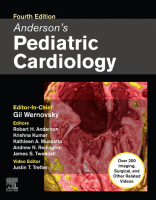Physical Address
304 North Cardinal St.
Dorchester Center, MA 02124

Historical Considerations When Siegal reexamined the original second century Greek text of Galen, he pointed out that Galen was familiar with many aspects of the fetal circulation even though he did not realize that blood circulated. Galen understood that fetal…

Introduction Common arterial trunk is an uncommon congenital cardiac lesion. The essential anatomic characteristic is the presence of a common ventriculoarterial junction that gives rise to an arterial trunk. This, in turn, gives rise to the systemic, pulmonary, and coronary…

Introduction Double-outlet ventricle is no more than an abnormal ventriculoarterial connection. Therefore the feature may occur with each atrial arrangement, any atrioventricular connection, and all possible variations of ventricular morphology. The morphologic arrangement can then be further complicated by associated…

Introduction The essence of congenitally corrected transposition is the presence of discordant connections at both atrioventricular (AV) and ventriculoarterial (VA) junctions. This segmental combination (like transposition itself, Chapter 37 ), can be found in patients with either usual or mirror-imaged…

Introduction The congenital malformation characterized by origin of the arterial trunks from morphologically inappropriate ventricles has probably been the source of as much confusion and controversy as any other single topic in pediatric cardiology. When Matthew Baillie described the first…

Introduction: Morphology This chapter deals with one of the most complex—and difficult to treat surgically—of all congenital cardiac malformations: tetralogy of Fallot with pulmonary atresia. We focus particularly on tetralogy of Fallot with pulmonary atresia (TOF/PA) and major aortopulmonary collateral…

Introduction Lev and Eckner made the appropriate statement that no two cases of tetralogy are exactly the same. Although that is fundamentally true, the characteristic anatomy permits its instant recognition as a phenotypic entity. It is appropriate that we continue…

The scope of this chapter is restricted to congenital lesions of the mitral valve. Anomalies of the mitral valve may also be caused by (or associated with) other congenital heart conditions or general diseases. See Table 34.1 and the chapters…

Introduction The most common congenital malformations afflicting the tricuspid valve are Ebstein malformation and tricuspid valvar dysplasia. These lesions are considered in this chapter, together with a brief look at acquired malformations. Tricuspid valvar abnormalities, or abnormalities of the morphologically…

Introduction Holes between the ventricles can occur as isolated anomalies but are also seen in association with many other defects. For example, they are found as integral parts of entities such as the tetralogy of Fallot, double-outlet ventricles, and most…